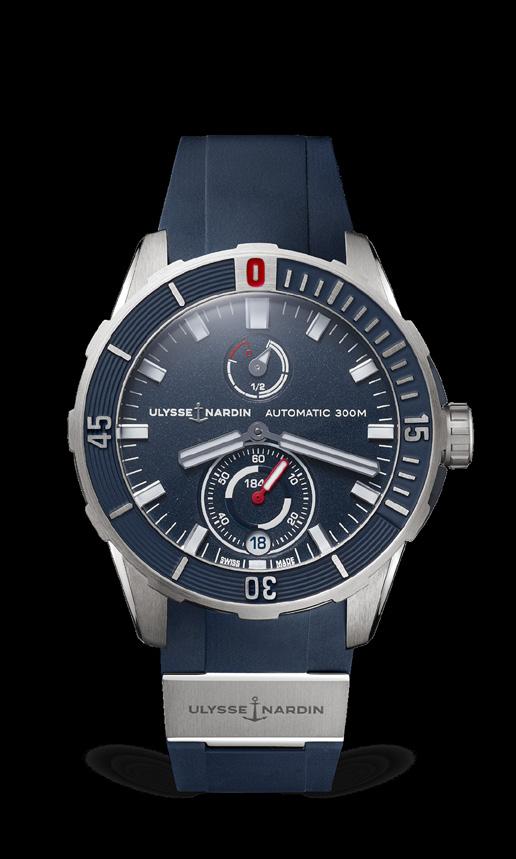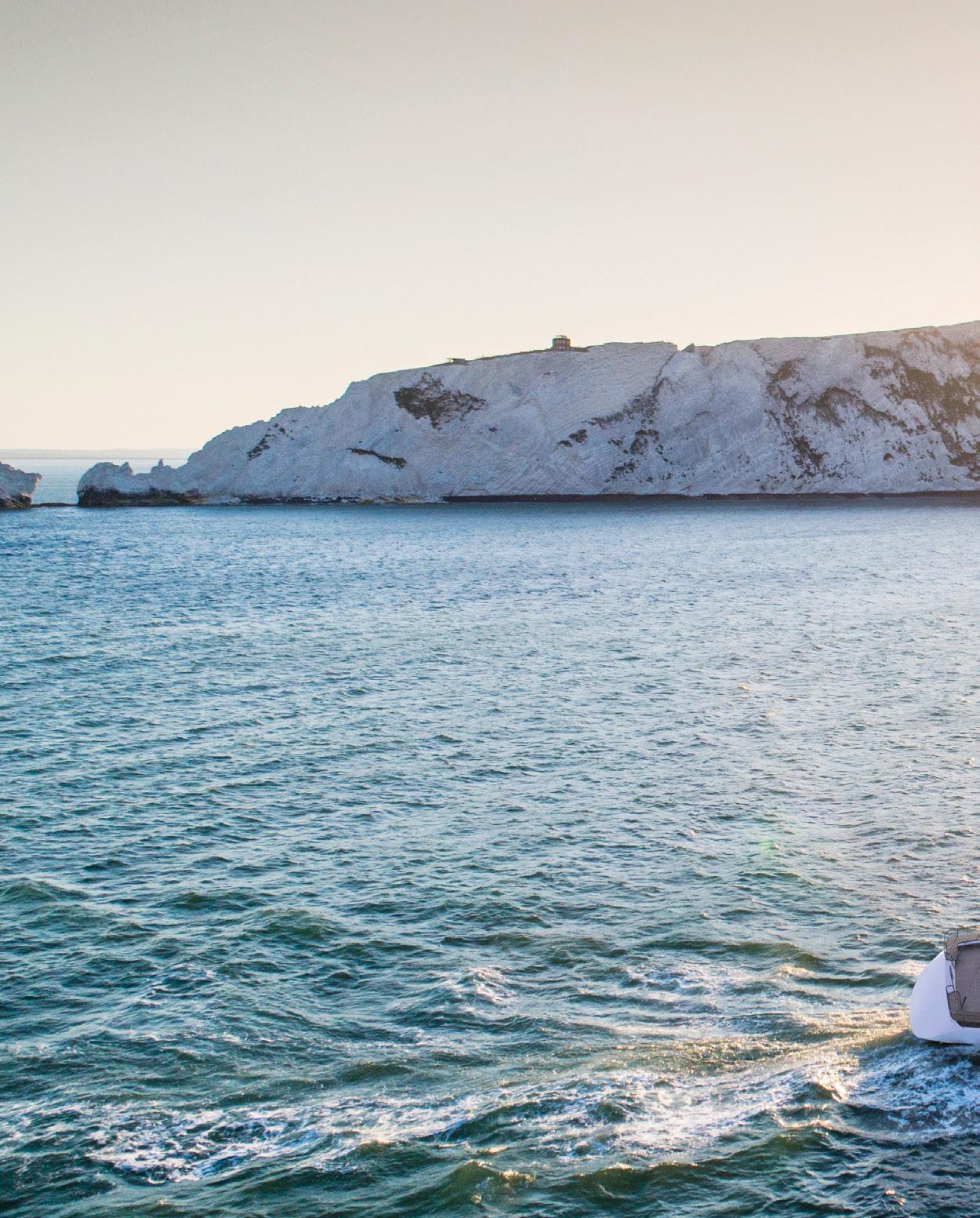
18 minute read
WHY CHARTER?
Chartering your yacht provides extraordinary value in terms of carefree luxury sailing.
Elaine Bunting finds out how it works.
With high hopes of sparking a love for sailing, Chris Shea first took his wife, Susan, on a holiday in Scotland in a 32-footer. They spent a week beating round Mull. “I thought we would live the dream,” he laughs.
Shea's family never quite shared his enthusiasm, he says, until 2014 when they decided to charter an Oyster 66 in the Caribbean. “I had been interested in Oysters for many years and when I started to be at the point where I thought I might be able to buy, I decided to charter.”
The moment Susan stepped aboard, he says, “she felt entirely confident in the crew running it. The hostess/cook and crewmate were lovely, entertaining women and it was great fun.” The level of luxury and comfort was a game changer. “The family thought: if this is what we are going to do, that is fine.”
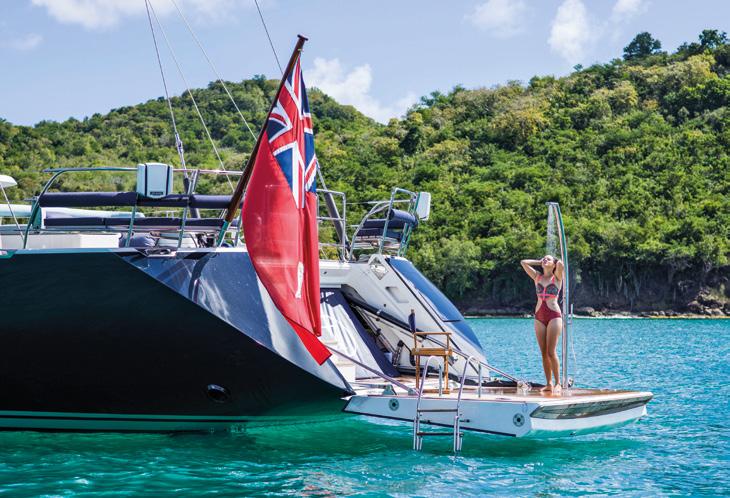
CHRIS SHEA
Once bitten by the Oyster bug there was no going back. The following year an order for a new Oyster 56, Magrathea, was on the books, followed two years afterwards by an Oyster 72. Both were immediately and continuously marketed for charter through the Oyster Charter service until the Sheas sold Magrathea in 2015. Charter allows owners to offset the costs of running their boat and employ crew to maintain it year round. That can keep a yacht in prime order and provide extraordinary value in terms of carefree, luxury sailing and boat ownership.
After crossing the Atlantic in his Oyster 54, Alan Parker found his horizons expanding. “I wanted to travel further, sailing in the Caribbean in the winter and the Mediterranean in summer, and maybe even further into the Pacific,” he says. He owned a property in Mallorca and thought that an Oyster 82 “could be the same as having a villa but be mobile”, so he sold the villa and bought the five-year-old Dama de Noche for charter and his own use. “It has turned out to be a great combination. I have a large boat for my personal use but at the same time I have an income from the chartering business,” he says.
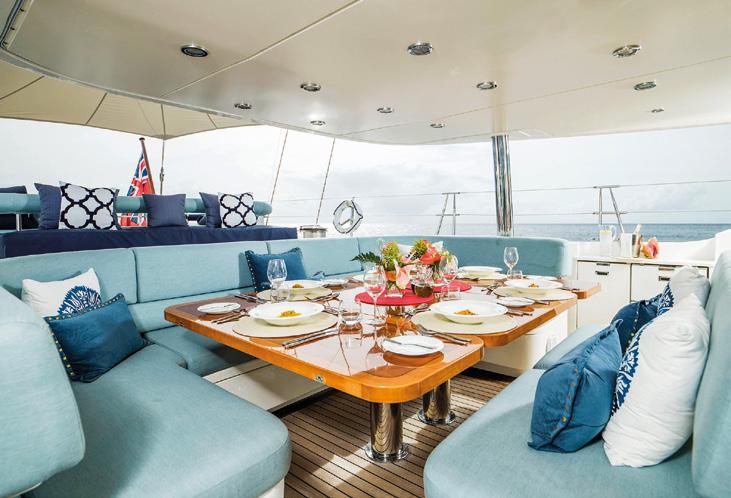
ALAN PARKER
Having a full-time professional crew means Parker and his family get to use their boat perhaps more than they might otherwise do. "Being a charter boat it is used much, much more, doing the Caribbean season in winter and the Med season in summer so we are chartering 12-20 weeks a year. But we use it ourselves for about ten weeks a year and we’ve crossed the Atlantic twice,” he says. “Our experience with charter is that you tend to have bigger horizons and go more places.”
LEFT:
OYSTER CHARTER PROVIDES ACCESS TO LOCATIONS IN THE MEDITERRANEAN, CARIBBEAN AND EAST COAST OF THE US. NO CHARTER NEED BE THE SAME.
WHY CHARTER?
Oyster’s charter management service was set up in 2005 by the then company owner Richard Matthews and Molly Marston. Chartering is something to be considered by anyone who is thinking of buying a yacht large enough to require crew, says Marston, Head of Oyster Charter.
A full-time crew will establish a consistent maintenance schedule, deliver the yacht to where it should be and look after the day-to-day minutiae. Working together with the crew to coordinate the charter and schedule details, Marston’s aim is to alleviate ‘ownership angst’. “You shouldn’t have to think about your yacht except when you’re using it,” she says.
MOLLY MARSTON
Richard Matthews owns an extended Oyster 82, Midnight, which he charters through Oyster for about eight to ten weeks a year. “We give charter bookings a priority and then use the time around it,” he explains.
But he emphasises: “The key to the whole thing is understanding that most owners don’t expect to turn a profit, they do it as a way of offsetting running costs. For me, going back 30 years, I have always taken the view that it keeps the boat in better condition and I have the boat moved around. Chartering makes sense, otherwise a boat is like a horse in a stable: it continues to eat.”
THE RIGHT FORMULA FOR CHARTER
So what is the right size of yacht for chartering and what are the costs and income that you could expect? Molly Marston says that “56ft and above” is ideal. Yachts of between 60ft and 70ft would need two crew and from 80ft upwards you would need three: a skipper, mate and stewardess. The Oyster 885 is something of a sweet spot, in that it borders on superyacht territory yet stays within the 24m ruling for charter coding. Above this size, additional crew, such as an engineer and another stewardess, would be required.
Typical rates for charter vary from €18,000 a week for an Oyster 625 to €45,000 a week for an Oyster 885. If using the Oyster charter service, the owner will net 80% of that.
A yacht has to be available in the right places at peak times, typically in the Caribbean over the winter, and the Mediterranean or New England in the summer. During the winter season from December to April, it is possible for an owner to sail for three weeks and charter their yacht for between four and eight weeks (the latter if the yacht is new) before heading across the Atlantic to Europe.
Owners who want to maximise income have to be reasonable about the use they make of it themselves, says Molly Marston. “But that won’t compromise your enjoyment with reasonable use,” she says.
BELOW:
THE HIGH-STANDARDS OF FINISH AND PRACTICAL LAYOUTS OF OYSTERS MAKE THEM THE PERFECT CHOICE TO CHARTER.


“As a business, it depends how much personal use you are going to get out of the boat – that is the 64,000 dollar question,” agrees Richard Matthews. “Where and when are you using it and does it leave enough capacity to have a viable business as well?”
“In most cases, I would say yes, but it depends on family circumstances. It works really well provided you don’t have expectations to use your yacht continuously in the high season. You will need to be realistic. Christmas, Easter and the high season of July and August are prime times and if you want to use it then yourself, you may be disappointed,” he advises.
“With the right crew, you offset potentially 50% of maintenance costs with a handson approach, ongoing work that would otherwise need to be paid for. And it is a huge advantage that you can turn up and your boat is totally ready to go and the menu planned.”
HOW DOES CHARTER WORK?
Oyster Charter advises on everything from the best layout and models when considering a new build or buying a brokerage yacht for charter, to what equipment and guest amenities are popular. It will also recommend a management company to help with corporate set-up and regulatory requirements, such as MCA coding and MLC compliance, which may be needed to ensure the vessel is legal to charter.
Oyster Charter markets the yacht worldwide to clients and industry brokers, puts together all the contacts and charter schedule, handles funds and is the liaison between owner, crew and guests. A starting point is always understanding how much an owner wishes to use their own boat, and where.
“The service means you don’t have to worry about all the contractual and payment issues,” says Chris Shea. “Much more significantly, Magrathea was marketed with full knowledge of my own plans for her use. Prospective customers were matched with the way we liked the boat and the crew to be used.”
“It is totally flexible and I adapt a programme to meet the owners’ views,” says Molly Marston. “If someone only wants to charter two weeks per year, that is fine. If they want as much as possible, that is also fine. The goal is to make chartering a good fit with each owner. We are one of the only companies with in-house charter management and it’s like a boutique – it is customised for the owner and it has to feel right.”
RICHARD MATTHEWS
Most owners operate their yacht as a business and offset business costs, which means that they pay the charter fee and VAT in the country where they use their boat. “You can’t run with the hare and hunt with the hounds,” cautions Richard Matthews. “People fall into the trap of trying to have the best of both worlds and that is not realistic. EU countries have different rules pertaining to charter and a lot require a licence and undertake safety checks.”
RIGHT:
PROFESSIONAL CREW WILL MAINTAIN YOUR YACHT, REDUCE GENERAL MAINTENANCE AND IMPROVE RESIDUAL VALUE.
He counsels that a good crew is fundamental in making charter work. Finding the right people is also something Oyster undertakes through its introduction and vetting service.
“It’s all about having the right crew,” he says. “You are in a confined space and the crew have to strike the right balance as people have different expectations. They could want fine dining or hands-on sailing, or a party, or family time with swimming, snorkelling and paddleboarding.”
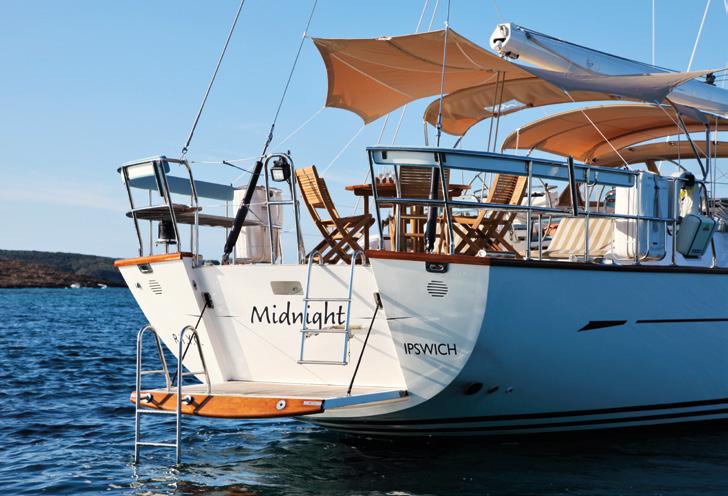
RICHARD MATTHEWS
But he believes that running as a charter business actually helps with getting a suitable skipper and crew. “Good crew don’t want to sit on the dock. They are there because they love the sailing,” he says. Owner Alan Parker agrees. “You tend to find people who are more experienced and like being charter skippers and that opens up new possibilities,” he says.
TRY IT OUT BY CHARTERING A YACHT
If you want to know whether owning and chartering is for you, there is no better way than chartering someone else’s yacht first to experience how it works. It enables people who are not expert sailors to learn from professional crew. Guests don’t need any sailing knowledge at all, or they can be super energetic, do lots of miles and get hands on.
Even if you decide to buy an Oyster, chartering can be worthwhile. Chris Shea did exactly that while his Oyster 72 Magrathea was being built. “Building times are substantial so there is plenty of sailing to be done before delivery. There is also the issue of deciding on the options. What better way than to review them on real boats? Better yet, why not quiz the crew mercilessly about what should and should not be added. The skipper of our third charter must have been climbing the wall with my incessant questioning as we sailed the Croatia coast."
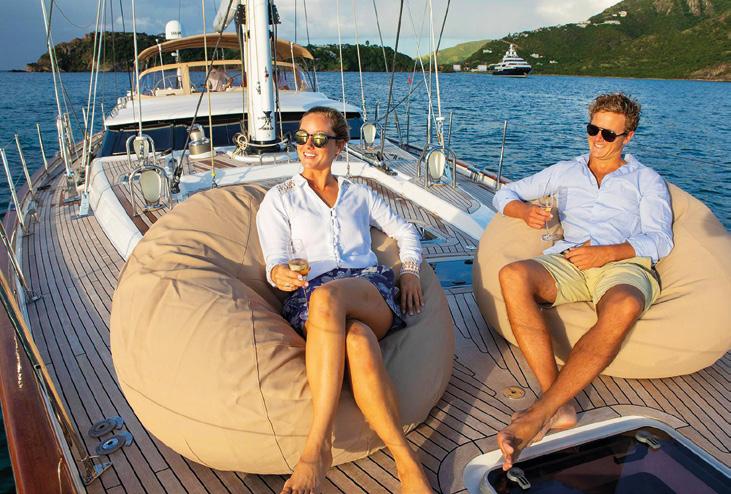
Now he has sold his yacht and is back to chartering on other people’s, he looks back on the experience as entirely positive. “Our crew were very careful and respectful of our feelings. It was extremely good, the boat was never damaged, the crew were happy and we had all the charters we wanted.”
Alan Parker says: “It has turned out to be a great combination having a large boat for our own personal use and at the same time an income. I am retired now so I could possibly squeeze in more time in terms of long distance trips and potentially go around the world or to New Zealand. That is going into a different phase of usage, though. For now, I have got a very happy medium.”
CHRIS SHEA
LEFT:
OYSTERS OFFER SOMETHING FOR THE WHOLE FAMILY - WHETHER YOU WANT TO SOAK UP THE SUN OR SOAK IN THE SEA.
BELOW:
THE SIGNATURE OYSTER DECK SALOON IS THE PERFECT PLACE TO RELAX WHEREVER YOUR CHARTER TAKES YOU.
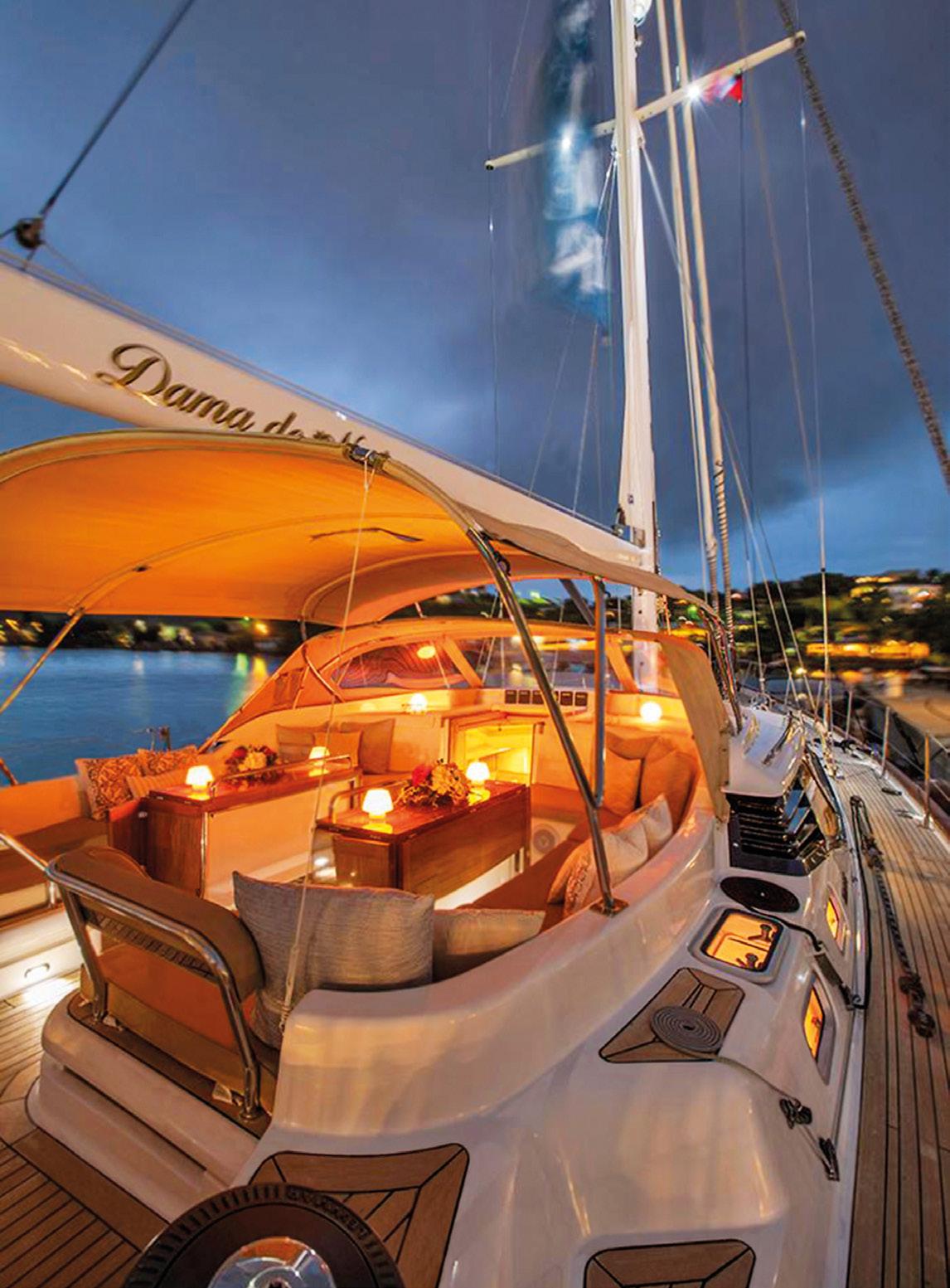
OWNER’S
STORY The Oyster Life OYSTER 575-32 – MASTEGOT HELENA DE FELIPE SEMPERE, AND PAU SERRACANTA
As director of Dorna Sports, Pau has been flying around the globe for the last 22 years organising (amongst many other things) the MotoGP World championships. Helena has her own sales and marketing consultancy serving luxury hotels. Early in lockdown, they decided to relocate, with son Gabriel, to their Oyster 575-32 Mastegot, moored in Port Vell, Barcelona.
The change has been wonderful. For the last seven months they have lived and worked from Mastegot and made the most of their time. “It feels like summer has gone on forever, yet it’s also passed by so quickly,” Helena says. For Gabriel, it’s been the summer of a lifetime. “Even going back to school was more fun,” he said, “because I could jump off the boat, down the pontoons through the marina to school. After school, my friends would come back and hang out on Mastegot. Most days, Dad would get the tender out and we’d go swimming and wakeboarding.”
For Pau, it meant a welcome break from 22 years of flying around the world on business. “I enjoyed more time on Mastegot moored in Barcelona when Gabriel attended the school, or sailing around the south of France and the Balearic Islands in the summer months.”
But even an idyllic lifestyle comes with its own challenges. “I have to be really careful with the camera angles on video calls on board,” says Helena with a big smile. “One of my clients, who actually owns a boat too, is a little jealous of the Mastegot’s interior.”
Pau’s passion for motorcycles and yachts started young. Against his parents’ wishes, he competed in motorcycle races before deciding to make it his career rather than his hobby. “I was a keen windsurfer when I was 15 and bought my first cruising boat when I was 28. It was nothing like this,” he laughs. “Very basic, no hot water, no fridge, no autopilot, but we loved cruising around the Balearics in it.” Helena was also a keen sailor when they met, and Pau’s son Gabriel was practically born on the water. “We gradually increased the sizes of our yachts, from 27 ft, 36 ft, 42 ft, then 53 ft.” The family have all gained their sailing qualifications, with Gabriel taking his Coastal Skipper just after his 16th birthday. Oyster 575 owners Pau Serracanta and Helena de Felipe Sempere discuss becoming part of the Oyster family, life onboard during the pandemic, awaiting delivery of their 595 and preparing for an Oyster World Rally.
PAU SERRACANTA

THIS PAGE:
MASTEGOT AT ANCHOR AT FORNELLS (MENORCA) BEFORE SUNSET, DURING HALLOWEEN WEEKEND. WEATHER WAS STILL FINE TO ENJOY MENORCA WITH ZERO CROWDS.
TOP:
AT ANCHOR IN SA RIERA (COSTA BRAVA) WITH GOOD 4G CONNECTION TO WORK FROM THE BEST “OFFICE”, MASTEGOT.
BOTTOM:
HELENA AND HER MOTHER MIDDAY SAILING IN BARCELONA AT THE BEGINNING OF JUNE.
Pau’s Oyster epiphany happened midway across the Atlantic, while taking part in the ARC rally two years ago, “I won’t say what make it was, but myself and a couple of friends were sailing a brand new 62 foot production boat across to St Lucia, and the boat had a lot of problems,” he explains. “I’d always dreamt of having a really nice boat to sail around the world in, and that’s when I knew I wanted an Oyster. I wanted a boat that was the absolute best for safety and quality.”
The family had seen lots of Oyster yachts during their time spent cruising around Mallorca, and especially in Palma where the Oyster Service Centre is located. They were delighted when they found 575-32 for sale through Oyster Brokerage. “She was in excellent condition,” says Helena, “and we really liked the layout and cabin configuration. She’s very light and airy inside.”
Renamed Mastegot, the boat was booked into the Oyster Service Centre in Palma for minor interior modifications before she was handed over. “I’ve only got one word to say about the team at Palma,” says Helena, “and that’s excellent! I cannot praise them highly enough. Every single member of staff is professional, well-trained and welcoming.” I’ve only got one word to say about the team at Palma, and that’s excellent! I cannot praise them highly enough. Every single member of staff is professional, well-trained and welcoming.
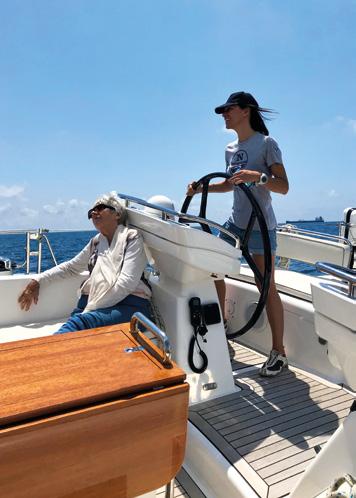

Pau agrees: “If you’ve been cruising and anything needs fixing, however small, you just call up and book in. It’s a fantastic service.”
The Oyster 575 exceeded Pau’s expectations – in fact, she was a dream come true. “She’s even better than I had hoped,” he says. “She’s a solid boat, so she’s really good at sea and for a high-quality, well-equipped boat, much faster than I expected.” Even in average winds, Mastegot easily exceeds eight knots. Easy to live aboard, she became home from home for the family. “Every boat we’ve owned has been called Mastegot,” says Pau. One of five children, he recalls his father telling him off for being naughty with his sisters. Pau’s father would say: “Behave, or you’ll get a mastegot!” Roughly translated from Catalonian, mastegot means a smack or a scolding. “I like the irony!” laughs Pau.
Fuelled by his work, Pau’s passion for speed is part of the reason why they decided to upgrade their much-loved 575 to a new larger and faster 595, currently in build. “It’s going to be a quicker boat, and that’s what we want when we sail long passages around the world,” says Pau. They are planning to take part in an Oyster World Rally in their new 595 (which will also be called Mastegot, of course!). Gabriel will be at University by then, so he will fly out and join them on various legs and stop-overs during the circumnavigation.
THIS PAGE:
THE PASSAGE TO CALA PREGONDA (MENORCA) WITH FRIENDS, ON HALLOWEEN WEEKEND.
RIGHT:
JUSTINE WITH LEAD PROJECT MANAGER DEBBIE SCOUGALL AT THE OYSTER PRIVATE VIEW, ST KATHARINE DOCKS, LONDON. She’s even better than I had hoped. She’s a solid boat, so she’s really good at sea and for a high-quality, well-equipped boat, much faster than I expected.”
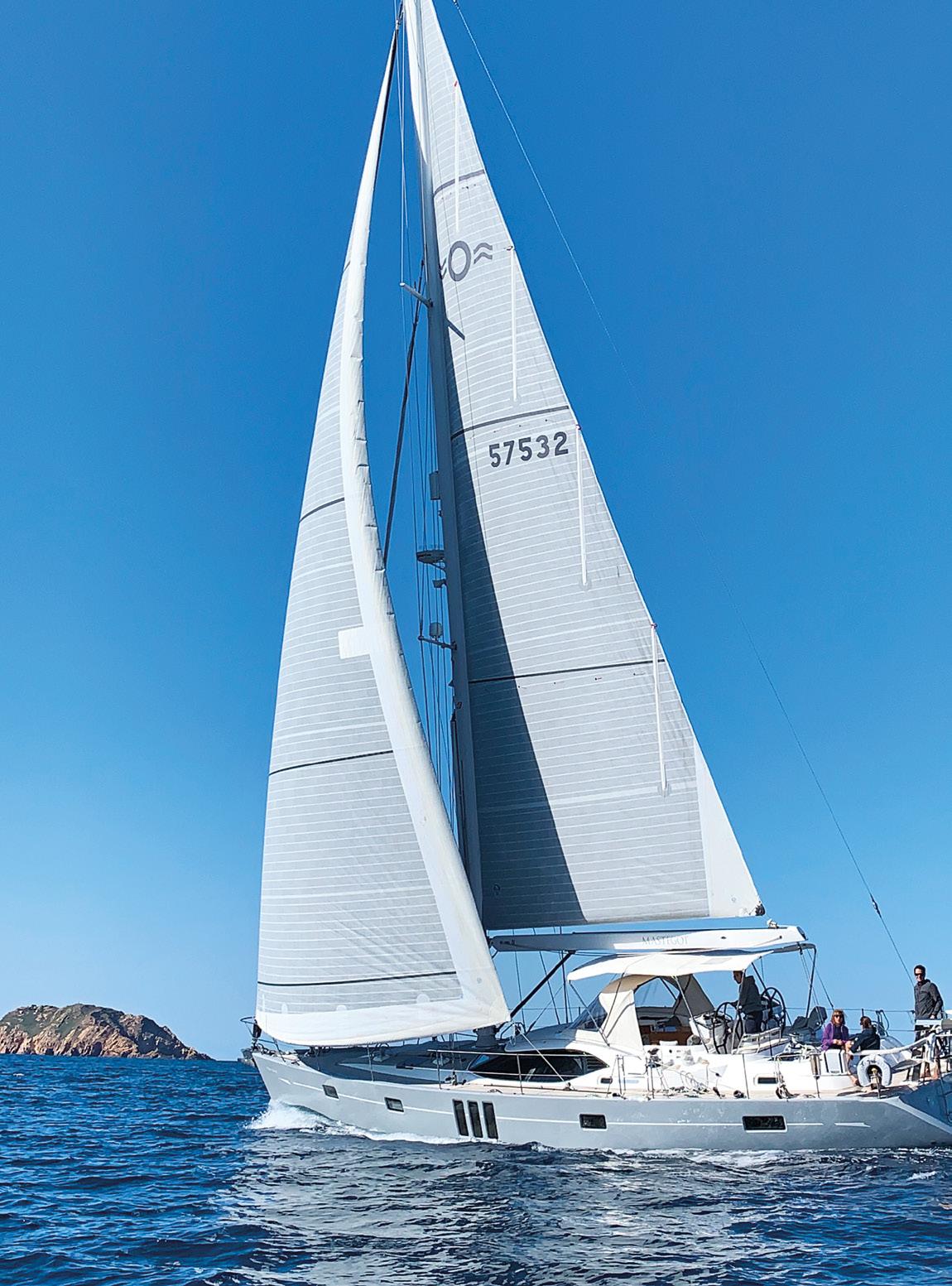
PAU SERRACANTA
TOP:
PAU AT THE HELM DURING A QUICK MID SEPTEMBER SAIL IN BARCELONA. HIS FAVOURITE POSITION IS ALWAYS LEEWARD TO CHECK THE GENOA.
BOTTOM:
GABRIEL ON THE BOOM IN LIGHT BREEZE, PALAMOS (COSTA BRAVA) BEGINNING OF JULY.
For both Pau and Helena, this longterm plan means they have time to make some changes to their working life too. “I will keep a couple of my key clients, who will know and understand that
I am travelling, and that I may be out of contact for a while,” says Helena. Both are looking forward to taking a step back from the everyday pressures of work and really enjoy the experience.

“The boat will have good communication facilities on board, but we don’t want to be under pressure from work while we’re sailing,” Helena says. “It’s more important that we can keep in contact with Gabriel and our parents.” Although they intend to slow down from work, it doesn’t apply to their sailing. One of the attractive features of the 595 is its hull shape and bow which are optimized for speed. “I like the twin rudder system and the fixed bow sprit too,” says Pau.
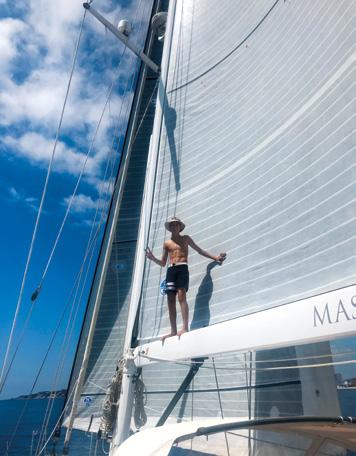
The family are working as a team on the specifications for their new boat, drawing on their experience of sailing and living on board Mastegot over the past seven months.
Oyster’s core qualities of reliability, high quality and safety have always appealed to the family. Pau remembers “When Gabriel was younger, I used to have nightmares about something happening to him when we were sailing. Now I’m excited to travel with him and Helena around the world with the Oyster World Rally. I know that with Oyster, we’ll be with an excellent team, in a very safe boat, with the best support and service.”
Their new boat is due for delivery in 2022, ready for the next Oyster World Rally. Pau says, “I’ve always dreamt of having a really nice boat to sail round the world. And my aspiration was always to have an Oyster.” Dreams, it seems, do come true.

